Seiza: The Art of Stillness and the Spirit of Japanese Grace
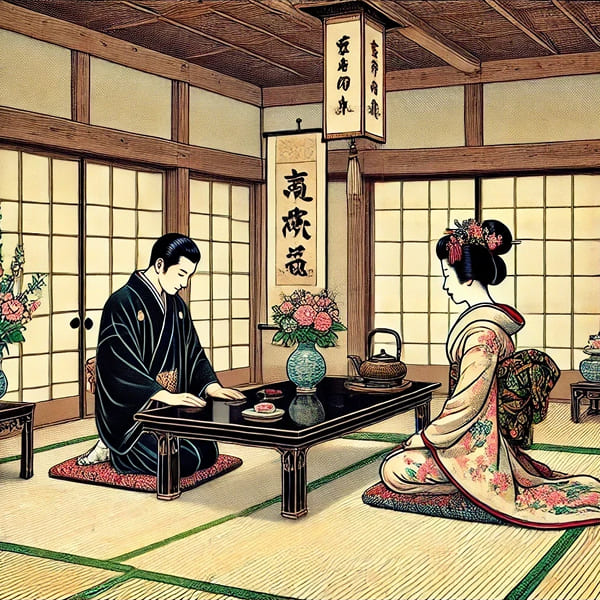
Contents
A graceful bow. A straight spine. A posture that speaks without words.
Imagine stepping into a quiet tatami room.
The air is calm, the faint scent of green tea drifts around you, and everyone kneels gracefully to the floor.
This is seiza—the traditional Japanese way of sitting.
Seiza is more than just a posture.
It is a quiet language of respect, discipline, and grace.
In this stillness, the body remains unmoving, yet the heart speaks softly through presence and composure.
So, let us take a quiet journey together— to discover the story behind seiza, its cultural meaning, and the Japanese sense of respect that lives within this timeless way of sitting.
What Is Seiza?
Before we dive into its deeper meanings, let’s first take a closer look at what seiza actually is—the basics of this elegant and distinctly Japanese way of sitting.
The Meaning Behind the Word
Let’s begin by thinking about the word seiza itself.
In Japanese, 正座 (seiza) literally means “to sit correctly” or “proper sitting.”
But what does “correct” mean in this context?
In Japan, it refers to a traditional way of sitting where both knees touch the floor, the legs are neatly folded beneath the body, and the hips rest gently on the heels.
The back stays straight, the shoulders are relaxed, and the hands rest lightly on the thighs.
It may look simple—but it’s a posture filled with grace and intention.

A Tradition Rooted in Daily Life
In Japanese homes, people traditionally remove their shoes indoors and sit directly on tatami mats.
Seiza has long been woven into the fabric of daily life as part of Japan’s everyday manners and sense of decorum.
Unlike sitting cross-legged, seiza naturally emphasizes grace, stillness, and an elegant awareness of posture.
Through this posture, one can express respect, confidence, and calm composure—all without saying a single word.
Where You’ll Encounter Seiza
So, in what kinds of situations do Japanese people sit in seiza? You’ll often see it in places such as:
- A tea ceremony room
- A martial arts dojo
- Formal occasions such as weddings or memorial gatherings
In each of these settings, seiza stands as a symbol of sincerity, discipline, and humility—a posture that connects body and mind, while reflecting Japan’s enduring sense of tradition.
Historical Background – From Samurai to Tea Ceremony
At first glance, it may seem that seiza has always been Japan’s standard way of sitting—but that wasn’t always the case.
So when did it become the formal posture we recognize today?
Let’s take a step back in time and see how seiza gradually evolved.
Origins: From Sacred Rituals to Signs of Respect
In earlier times, seiza was primarily used in religious and ceremonial settings.
People would kneel in seiza to:
- Worship the gods in Shinto rituals
- Pray before Buddhist statues in temples
- Show loyalty and submission before powerful leaders such as the Seii Taishōgun (shogun)
In daily life, however, people did not always sit in seiza.
They usually sat cross-legged (agura) or with one knee raised (tatehiza).
Traditional clothing—like the multi-layered jūnihitoe worn by Heian nobles, or the voluminous robes of Buddhist monks—made the seiza posture impractical.
At this stage, seiza was not an everyday sitting style, but rather a gesture of reverence—a way of lowering one’s body to show humility and respect before the sacred or the superior.
Edo Period: When Seiza Became the Samurai’s Etiquette
During the Edo period (1603–1868), seiza became firmly established as Japan’s official and formal way of sitting.
This development was shaped by two major influences.

The first came from the Tokugawa shogunate.
Under its strict code of conduct, daimyō were required to sit in seiza during official audiences before the shogun.
Sitting still for long periods—until one’s legs went numb—was seen as a symbol of obedience and a reminder of loyalty, discouraging any defiance among subordinates.
The second influence came from the growing presence of tatami mats in ordinary homes.
At the time, the kimono was the standard form of clothing, and seiza suited it perfectly.
Sitting in this posture helped the fabric maintain a neat and graceful shape, without creasing or spreading across the floor.
In this way, seiza spread throughout Japan—both as etiquette among the samurai and a daily custom among commoners.
It came to be valued not only for its practicality, but also for its refined appearance—a posture expressing both discipline and grace.
From the Meiji Era to Modern Japan
After the Meiji Restoration (1868), Japan entered a period of rapid modernization and began seeking a shared national identity.
Through moral education (shūshin), schools and society promoted seiza as a unified expression of respect, discipline, and courtesy—a posture that transcended differences in class and status.
By the early 20th century, seiza had come to represent more than just a practical way of sitting.
It became a symbol of Japan’s cultural refinement and shared values—reflecting the importance of harmony, respect, and beauty in everyday life.
Symbolism and Cultural Meaning
As we’ve seen, seiza has gradually evolved over the centuries to become a symbol of Japan’s cultural identity and shared values.
Now, let’s take a closer look at its deeper cultural meanings—and explore what seiza represents in the Japanese sense of respect, harmony, and beauty.
A Posture of Respect and Humility
In modern Japan, seiza is still regarded as one of the most refined forms of etiquette.
This is because the posture itself conveys attentiveness, sincerity, and a willingness to listen with respect—values that are deeply ingrained in Japanese culture.
To sit in seiza before someone is to show that you are fully present and engaged, that you approach the person with genuine respect and an open heart.
Even without words, the posture communicates a silent message of consideration and trust.

This reflects the Japanese belief that posture mirrors the heart.
Through seiza, one’s attitude and sincerity become visible.
It is a quiet signal that tells others,
I am here with honesty and respect.
In this way, seiza is closely tied to the core principles of Japanese manners—an emphasis on respect, sincerity, and awareness of others.
In Traditional Arts and Disciplines
The spirit of seiza—respect, sincerity, and mindfulness—extends beyond daily manners.
In Japan’s traditional arts and cultural disciplines, this same posture takes on an even deeper significance.
Here, seiza becomes not only a gesture of courtesy, but also a mark of refinement, dignity, and spiritual focus.
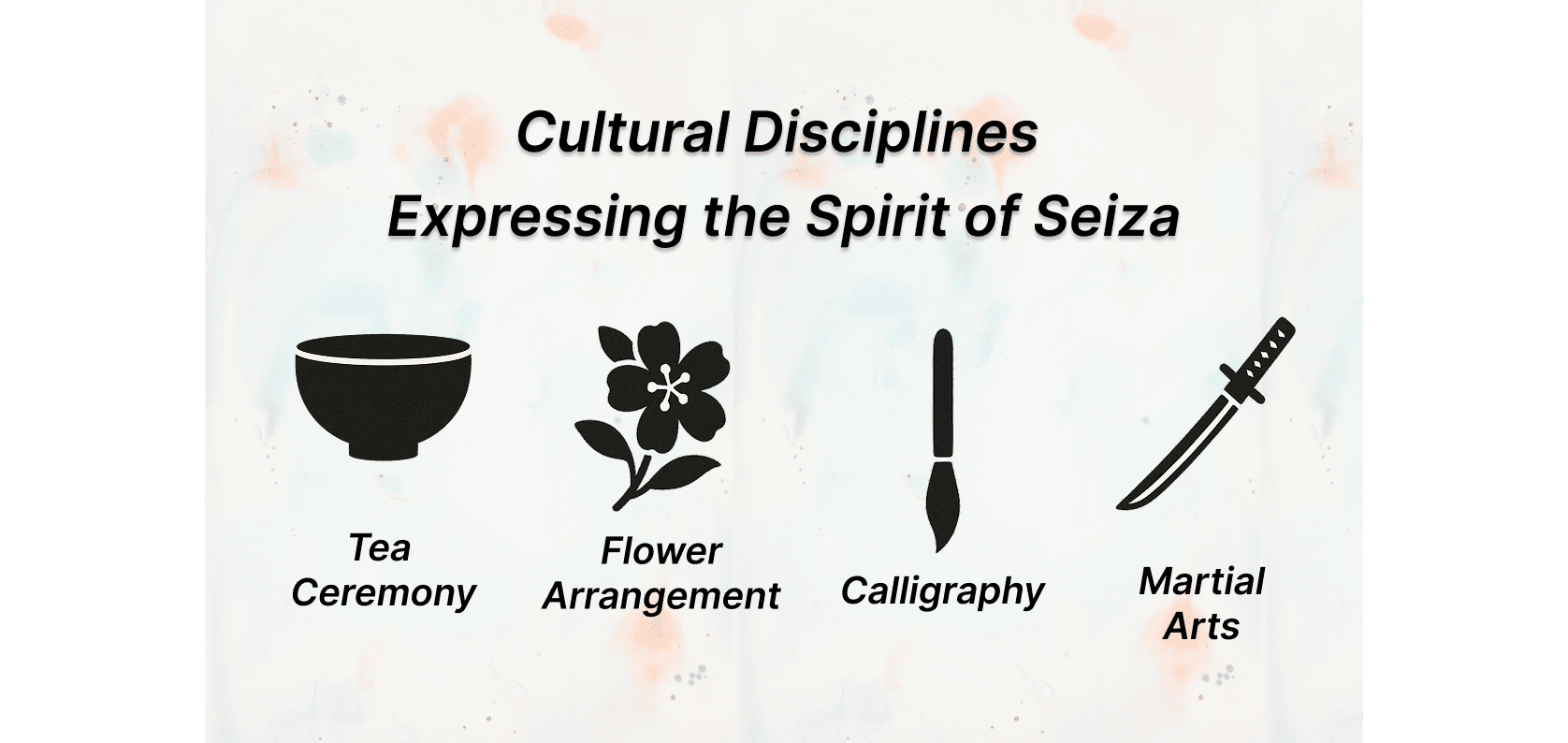
| Field / Art Form | What Seiza Expresses |
|---|---|
| Tea Ceremony | Graceful composure and silent respect |
| Flower Arrangement (Ikebana) / Calligraphy | Discipline, balance, and inner tranquility |
| Martial Arts | Gratitude, humility, and mental readiness |
| Performing Arts – Noh, Kabuki, Rakugo | Poise, elegance, and a quiet sense of strength |
Across all of these traditions, the seiza elevates the body into a form of artistic expression—a posture that unites outer grace with inner sincerity, revealing the harmony between form, spirit, and culture that defines Japanese aesthetics.
More Than Just Sitting
Seiza is not merely a posture. Within this simple act of sitting lies the very essence of Japanese culture.
Through seiza, one embodies Japan’s sense of balance between body and spirit, and the harmony between outer beauty and inner sincerity.
It reflects a unique aesthetic that finds meaning not in movement, but in stillness—a belief that even silence can express respect, presence, and refined beauty.
Seiza is more than a tradition; it is Japan itself, shaped in form. To understand seiza is to glimpse the quiet heart of Japan.
How to Sit in Seiza – Step-by-Step
Now that you have a deeper understanding of seiza, let’s take a closer look at how to sit in this posture.
Though it appears simple, sitting correctly has a curious effect: your posture naturally settles into elegance, and your mind feels a touch more refined.
Let’s walk through it step by step.
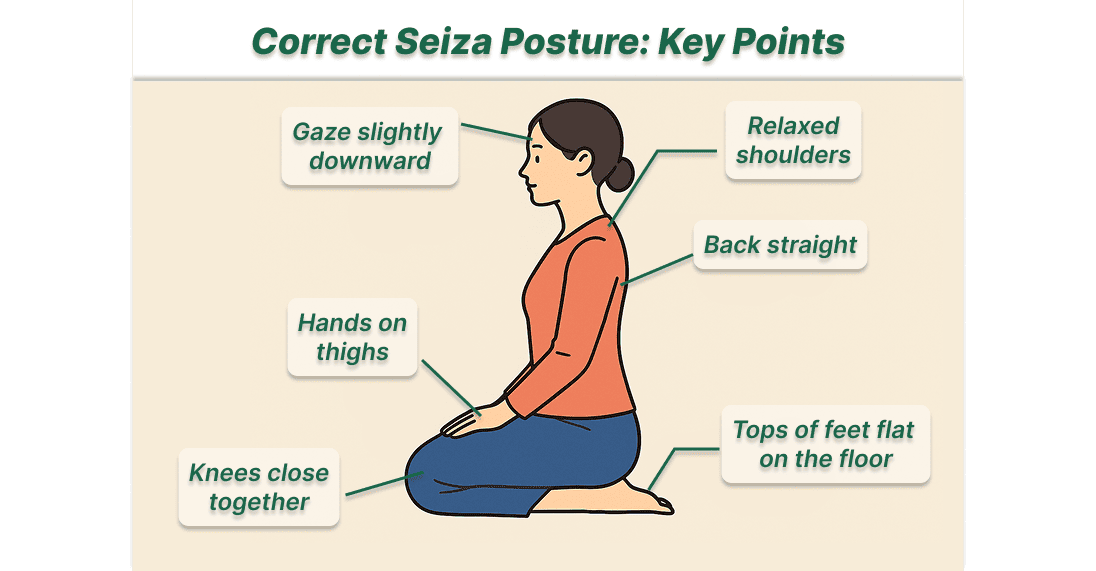
1. Start from a Kneeling Position
Kneel down with both knees together, keeping your legs parallel.
Your toes should point straight back, with the tops of your feet resting flat on the floor.
Take a moment to make sure you’re stable and relaxed before moving on.
2. Fold Your Legs Under You
Gently lower your body so that your buttocks rest lightly on your heels.
Distribute your weight evenly on both sides—try not to lean too far forward or backward.
3. Align Your Back and Shoulders
Keep your back straight but natural, as if a thread were gently pulling upward from the top of your head.
Relax your shoulders and let your chest open softly.
This will make your posture appear calm and confident.
4. Place Your Hands Neatly
- For men: place both hands on your thighs, fingers together, palms facing down.
- For women: place your hands on your thighs with the fingers slightly inward, creating a soft curve.
Your hands should rest gently—never stiff or forced.

5. Maintain a Calm, Steady Gaze
Look slightly downward in front of you.
Avoid crossing your arms, fidgeting, or shifting your weight too much.
Simply breathe and let your focus settle.
Does it spark a little curiosity in you?
Why not try it once—and feel what it’s like to sit in stillness, just as people in Japan have done for centuries.
Tips for Comfort and Endurance
Let’s be honest—seiza isn’t perfect.
Its one big drawback? Your legs can go numb after a while!
Even Japanese people find it difficult to stay in this position for long.
So how do they deal with it? Here are a few simple tricks you can try.
- Keep your back straight: A straight spine helps reduce pressure and keeps your posture elegant.
- Shift your weight slightly: Move some of your weight toward your thighs to ease the pressure on your ankles.
- Use a small cushion (zabuton): A thin cushion or a folded towel can make seiza much more comfortable.
- Take short breaks: If your legs start to tingle, lean forward like a stretching cat to restore blood flow before sitting back again.
With a little practice, your body will gradually get used to it, and you’ll find it easier to stay seated for longer.
Next time you have the chance to sit in seiza, try these tips—and enjoy the quiet beauty of the experience.
Seiza in Modern Japan
Once considered an essential part of everyday life in Japan, seiza has long been seen as a traditional posture.
But what role does it play in modern Japan today?
Let’s take a closer look at how this time-honored way of sitting continues to find its place in contemporary Japanese life.
Fewer Opportunities in Daily Life
In today’s Japan, people have fewer chances to sit in seiza than in the past.
The shift from tatami-floored rooms to Western-style interiors with chairs and sofas has changed how people live—and sit.
Many modern homes have only one tatami room, or none at all, so younger generations may encounter seiza only during special events or family gatherings.
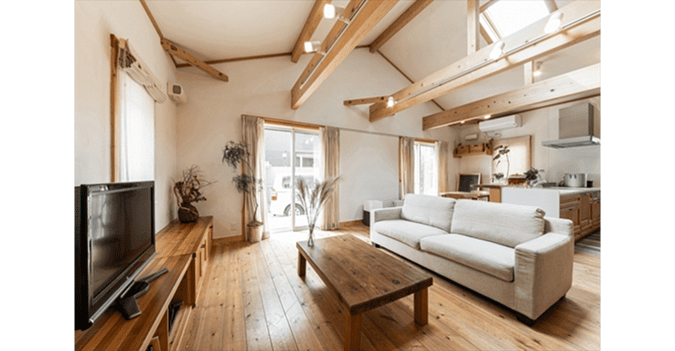
Still, for many Japanese, the image of seiza remains familiar—something seen at grandparents’ homes, on New Year’s Day, or during formal visits.
It’s part of the cultural memory, even if it’s no longer part of everyday life.
Formal Events Where Seiza Remains
While daily lifestyles have changed, seiza still holds an important place in Japan’s ceremonial and cultural traditions.
In tea rooms, martial arts dojos, and religious ceremonies, the posture remains a mark of respect and mindful presence.
It is also seen at weddings, funerals, and other traditional gatherings, where sitting in seiza expresses sincerity and reverence.

Even as the world around it has evolved, seiza continues to represent one of Japan’s enduring cultural expressions—a quiet posture that preserves the nation’s sense of dignity, respect, and spiritual grace.
Adapting to Modern Needs
At the same time, not everyone can comfortably sit in seiza.
For guests with leg or joint difficulties, maintaining the posture can be painful or even impossible.
To accommodate this, many venues now provide low chairs or backrests during formal gatherings.
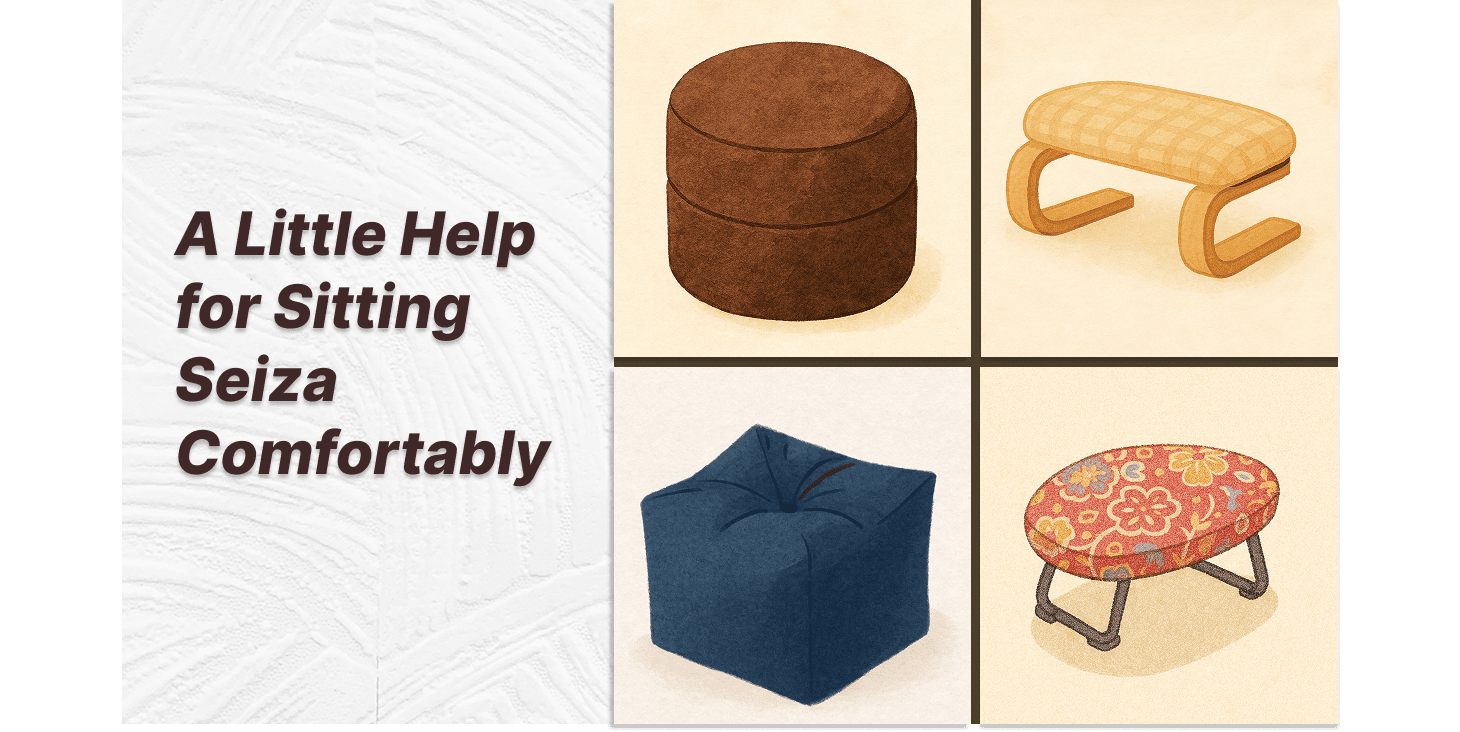
Seiza was once seen as an act of personal courtesy—but today, the spirit of that courtesy has expanded to the setting itself.
Today, hosts and event organizers show consideration and respect by creating spaces where everyone can feel at ease.
True politeness and respect do not come from enduring discomfort, but from fostering an atmosphere of kindness and harmony.
Modern Japanese etiquette embraces this balance between tradition and comfort, honoring both the beauty of the past and the needs of the present.
In this harmony between old and new, the spirit of seiza continues to live on—quietly adapting, yet never disappearing.
Conclusion – More Than Just a Way to Sit
Seiza may appear to be just one of Japan’s traditional ways of sitting.
However, within this posture lies centuries of evolution, shaped by a deep sense of consideration, etiquette, and a uniquely Japanese sense of beauty.
It reflects the inner heart—one of respect, sincerity, and thoughtfulness.

In modern Japan, lifestyle changes have made opportunities to sit in seiza less frequent. Yet even today, it continues to embody timeless values—respect, humility, and discipline—remaining an essential part of Japan’s cultural expression.
To sit in seiza is not only to experience a traditional posture, but also to understand the Japanese spirit itself.
Through this act, one can find elegance, refinement, and a moment of quiet focus.
Why not try sitting in seiza yourself—and feel the calm grace that has connected hearts in Japan for generations?